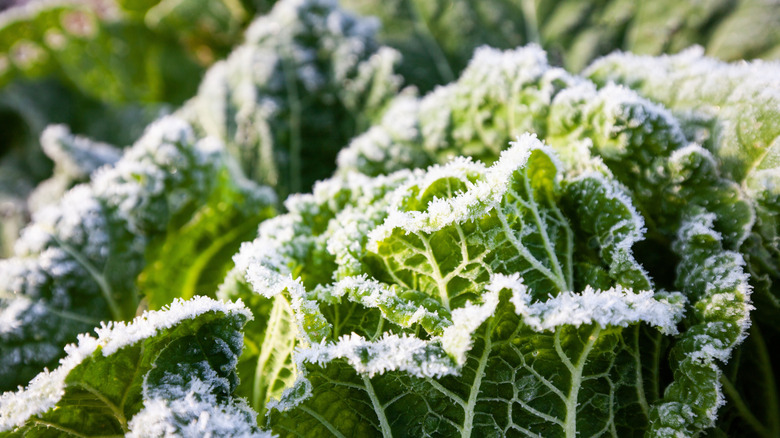The DIY Frost Cover That Adjusts To All Of Your Gardening Needs
Preparing to protect your plants before the temperatures dip below 32 degrees Fahrenheit should be a top priority for every gardener. That's the level where a light freeze could kill your sensitive plants, while temps below 28 degrees could cause some damage to many other plants. When the cold goes below 24 degrees, you're talking heavy damage. Many plants suffer from frost because when the temperatures dip past a certain level, the water within the plant cells freezes, expands, and ruptures the cell. Once damaged, the cells can't function properly, and the plant or part of the plant dies. Note that there are only 8 degrees between light and severe frost, making it essential to know how to properly cover your plants from the frost of all levels. From the Garden on Instagram got creative with 16 gauge wire, paracord, and cloth to create a DIY adjustable frost cover to protect plants. The easy-to-make system is designed to stay open when temperatures are favorable and close when it dips below freezing.
The most sensitive plants susceptible to frost damage tend to be annuals that thrive in warm temperatures, like many vegetables and herbs that produce in the middle of the summer. While some vegetables you should wait until after a frost to harvest, like broccoli, collards, and cabbage, crops like tomatoes, basil, summer squash, and cucumbers need protection from the elements. To help them survive the cold, you need to cover these sensitive plants either individually using covers like milk jugs or collectively using materials to design a row cover. Larger plants like shrubs will require big swaths of material for protection.
Designing your adjustable row cover
From the Garden took 16 gauge wire and cut it so that when bent into an arch, it hovered over the plants she wanted to protect without touching them. Then, she bent a small loop near each end of all the wires, leaving enough length to push into the soil as an anchor. The number of wire arches you'll need depends on how long you need your row cover to span to support the fabric cover adequately. Once your wires are prepared, shove one end into the soil up to the loop on each side of your plants and cover the arches with fabric. Choose a breathable cloth specifically designed for frosts. One frost protection hack to avoid is using plastic, as the greenhouse effect will lead to more damage.
With your cloth in place, cut your paracord so it will reach from one side to the other — twice. Once cut, tie the ends together to form a rubberband structure. Stake the cord on one side, using the gauge wire loop as an anchor, drape it over the fabric to the other side, and stake it there too. After the frost, you'll be able to lift the fabric on each side, with the cord holding it on top of the arches. When frost comes again, simply lower the sides. You might even want to lower the sides when temperatures reach below 40 degrees Fahrenheit, just to be extra cautious. On their YouTube channel, Green Acres Nursery & Supply also recommends watering the ground underneath your plants before covering them. The moist ground will keep the area beneath the covering warmer, helping protect your plants.
